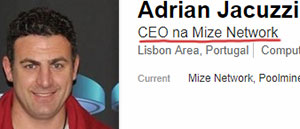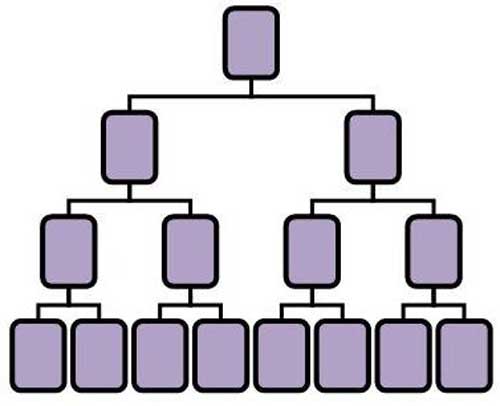PowerNodes Review: Mize Network’s Ponzi scam within a scam
![]() PowerNodes provide no information on their website about who owns or runs the company.
PowerNodes provide no information on their website about who owns or runs the company.
The PowerNodes website domain (“powernodes.io”) was privately registered on May 30th, 2018.
Inspection of the PowerNodes website source-code reveals “Mize Network” keyword stuffing:

The Mize Network logo is also featured in the footer of the PowerNodes compensation plan.
Further research reveals Mize Network affiliates promoting PowerNodes as the company’s “first product”.

 Mize Network was recently launched by serial scammer Adrian Jacuzzi (right).
Mize Network was recently launched by serial scammer Adrian Jacuzzi (right).
The core business model of the company is pyramid recruitment, with PowerNodes appearing to operate as a “business within a business”.
Read on for a full review of the PowerNodes MLM opportunity.
PowerNodes Products
PowerNodes has no retailable products or services, with affiliates only able to market PowerNodes affiliate membership itself.
The PowerNodes Compensation Plan
Mize Network affiliates invest into PowerNodes on the promise of a “daily payment”.
No specifics regarding PowerNodes’ daily ROI payments are provided.
Recruitment Commissions
PowerNodes affiliates are paid a 5% commission on funds invested by affiliates they recruit.
Residual recruitment commissions are paid on reinvestment by recruited affiliates.
PowerNodes track residual recruitment commissions via a unilevel compensation structure.
A unilevel compensation structure places an affiliate at the top of a unilevel team, with every personally recruited affiliate placed directly under them (level 1):

If any level 1 affiliates recruit new affiliates, they are placed on level 2 of the original affiliate’s unilevel team.
If any level 2 affiliates recruit new affiliates, they are placed on level 3 and so on and so forth down a theoretical infinite number of levels.
PowerNodes cap payable residual recruitment commissions at nine unilevel team levels.
Commissions are paid out as a percentage of reinvested funds across these nine levels as follows:
- level 1 (personally recruited affiliates) – 3%
- levels 2 and 3 – 3%
- levels 4 to 6 – 2%
- levels 7 to 9 – 1%
Residual Commissions
PowerNodes pay residual commissions via a binary compensation structure.
A binary compensation structure places an affiliate at the top of a binary team, split into two sides (left and right):

The first level of the binary team houses two positions. The second level of the binary team is generated by splitting these first two positions into another two positions each (4 positions).
Subsequent levels of the binary team are generated as required, with each new level housing twice as many positions as the previous level.
Positions in the binary team are filled via direct and indirect recruitment of affiliates. Note there is no limit to how deep a binary team can grow.
At the end of each day PowerNodes tallies up new investment volume on both sides of the binary team.
New investment volume is calculated at a rate of 70% of funds invested across the binary team that day.
Affiliates are paid 10% of matched funds on their weaker binary side.
Leftover funds on the stronger side are carried over to the following day.
Matching Bonus
PowerNodes pay a 5% Matching Bonus on residual commissions earned by downline affiliates.
The Matching Bonus is paid out using the same unilevel compensation structure as residual recruitment commissions, capped at five levels of recruitment.
Joining PowerNodes
PowerNodes fail to provide any information regarding affiliate membership and investment costs on their website.
One would assume Mize Network affiliate membership is a requirement (€50 to €25,000 EUR), with additional PowerNodes investment and reinvestment on top of that.
Conclusion
A visit to the PowerNodes website reveals nothing about the corporate structure of the company.
This is by design, as there’s a calculated effort to present PowerNodes as a stand-alone company.
When a scam collapses, there’s typically a rush to recruit victims into another scam.
Sadly the promise of recovering lost funds in a new scam proves all to tempting for victims, only for even greater losses to occur once the reload scam goes belly up.
Prior to Mize Network, Adrian Jacuzzi was promoting Pool Miners.
This exact same scenario played out, with Pool Miners affiliates shuffled into Infinitum Flame when it inevitable collapsed.
By creating a “scam within a scam”, Jacuzzi stands to retain the highest number of victims when PowerNodes inevitably collapses.
All he has to do is launch a “second product” when Mize Network recruitment drops, followed by a “third product” and so on and so forth.
Eventually even the most gullible of investors will stop reinvesting, but by then Jacuzzi will have achieved his goal of stealing as much money from as many people as possible.
With respect to PowerNodes’ business model, the company claims to be mining some ERC-20 token they’ve taken five minutes to set up.
Other than there being 170 million of them, no details of the token are provided.
Something to be wary of, is the issuing of an ERC-20 token also serves as a means for Mize Network to wipe ROI liability at will.
All Jacuzzi has to do is maintain an internal token value facade (based on nothing).
Then once real money ROI revenue starts to dry up, start paying Mize Network affiliates out in pre-generated PowerNodes tokens.
Push some marketing garbage about “having your own cryptocurrency” and how it’s “sure to increase in value” (again, based on nothing), and then let your affiliates squabble it out as the internal value of the tokens plummets to zero.
Obviously neither Mize Network, PowerNodes or Adrian Jacuzzi are registered to offer securities in any jurisdiction they operate in. Which means at a base level the company is operating illegally worldwide.
Secondary perhaps to Ponzi and pyramid fraud from a potential investor point of view. Still worth keeping in mind though because from a regulatory standpoint that’s the angle PowerNodes will be approached from.
Other than that, expect the usual “omg proof of mining!” evidence to surface at some point.
You know the drill, stickers on mining equipment in some undisclosed location. Shaky YouTube videos and temporary company logo banners tied up to mining rigs.
Everything except actual disclosure and required regulatory registration.
We’ve been down this road plenty times before with MLM cryptocurrency cloud mining schemes. It never ends well.


Great article as always.
Did you ever do a review on a legit crypto mining mlm company?
You feeling some sort of way your scam of the week was exposed?
Maybe you can direct OZ to one you find in the future!!
Shall I state the obvious?
There aren’t any to review!!!
@Steve
I might be mistaken but I don’t recall any MLM cryptocurrency being registered with the appropriate authorities.
The big ones always trot out legal opinions citing regulatory exemption. Which is great, until they’re inevitable served securities fraud cease and desists.
@Steve Jabs-apparently you don’t read much! Regulators have deemed MLM programs that involve the buying and selling of new coins and initial coin offerings, bitcoin mining, and trading to be illegal ponzi/pyramid schemes, as they are considered to be promoting an investment, a “security,” or in the case of bitcoin mining, an unregistered security, without the company AND all of its reps having a securities license!
That’s why you find a review on any “legit” crypto-currency and/or mining related MLM program!
I would suggest reading this article from Jeff Babener, widely considered the MLM industry’s top attorney, who also gives kudos to behindmlm.com in his article for exposing blatant, illegal ponzi and/or pyramid schemes like Mize Network and PowerNodes!
I would also recommend listening to this audio clip from the #1 radio show in the world on the network marketing industry, the Tom Chenault Show.
They recently had a roundtable of top MLM industry attorneys and the head of the MLMIA on a program, all warning people to avoid any MLM program promoting the buying and selling of crypto-currency and a new coin, initial coin offering, bitcoin mining, etc. soundcloud.com/tony-cannuli/tom-chenault-show-cryptocurrency-nov-25-2017
Surely, you’re not going to be foolish enough to argue with top industry attorneys and consultants, are you?
To stick up for Steve Jabs I thought his comment was sarcasm. I see ‘crypto mining’ and that directly translates to Ponzi in my mind.
I’ve been following a ‘Power Couple’ on facebook who have been in more Ponzi’s than i’ve had hot dinners. Mize is the latest.
They got in on the Mize ‘shareholder and co-owner oppurtunity’ but that has ended. You can still buy your own powernode though.
Mize has a lifetime moneyback guarantee apparently, so it’s supersafe.
They are in at least 2 other Ponzi’s alongside Mize, because having more than one stream of income is the sensible thing to do.
I still haven’t figured out if they are really really stupid, or they are hoping they will join a Ponzi early enough that they will end up a Net Winner.
Personally I think they are just really really stupid.
There is inherently no such thing.
Any legitimate cryptocurrency can be mined by anyone with access to the necessary computing power. (If you have a cryptocurrency where mining is controlled by the scheme promoters, what you have is OneCoin, and is automatically illegitimate.)
Any mining company that used an MLM structure would therefore instantly find itself outcompeted.
Let’s say that for a brief instant there is only one company mining a given cryptocurrency and they use MLM. They mine coins on your behalf and pay you X-Y-Z, where X is the value of the mined coins on the open market, Y is the scheme’s own costs and profit margin, and Z is the commission payable to MLM agents down however many levels.
If it’s a legit coin, anyone can set up a non-MLM company mining the same coin and pay its investors X-Y. No matter what its marketing costs, it will be less than the MLM company because it has so many fewer mouths to feed.
Why would you invest with the MLM company and get X-Y-Z when you could invest with a non-MLM company paying X-Y?
This logic, of course, applies to any MLM company. Every single MLM company in existence, without exception, has a non-MLM competitor providing the same product at higher quality or lower price or both.
However, while in the long-term the economic laws of physics are irresistable, in the short-term you can disguise this by selling something like makeup or fruit juice and claiming it’s better than your competitors (even if all objective reviews show the contrary).
With crypto mining contracts there is no disguise. In the MLM company you get X-Y-Z and in a non-MLM company you get X-Y. If there is no non-MLM company, there soon will be. It’s easy money.
This is why MLM does not work in financial services. If you try hard you can con a few people into thinking that Younique’s shit makeup is better than Maybeline, but you can’t con anyone into thinking that a 5% return is better than 8%.
This company is no doubt not authentic period! Red flags all over ..
Im ashamed to have tried to participate scam or not. All money isnt good money!
Something smells fishy it probably is! Scam or not my sponsor totally admit he didn’t care about nothing or nobody but himself almost like the money was blinding him from the truth.
Dont be fooled into this company like i was.. money to be made or not the work ethic is horrible!
Part 2
Logged into the back office ( security issue ) without signing in. Also tried to submit a support ticket to no avail. (ERROR) warning signs all over the place….
Mize is back, with “PowerMine” this time, a scheme based on investment in Mongolian copper mining via a “Blue Hill Mining” STO, projected ROI 3340%…..
powermine.net/index.php